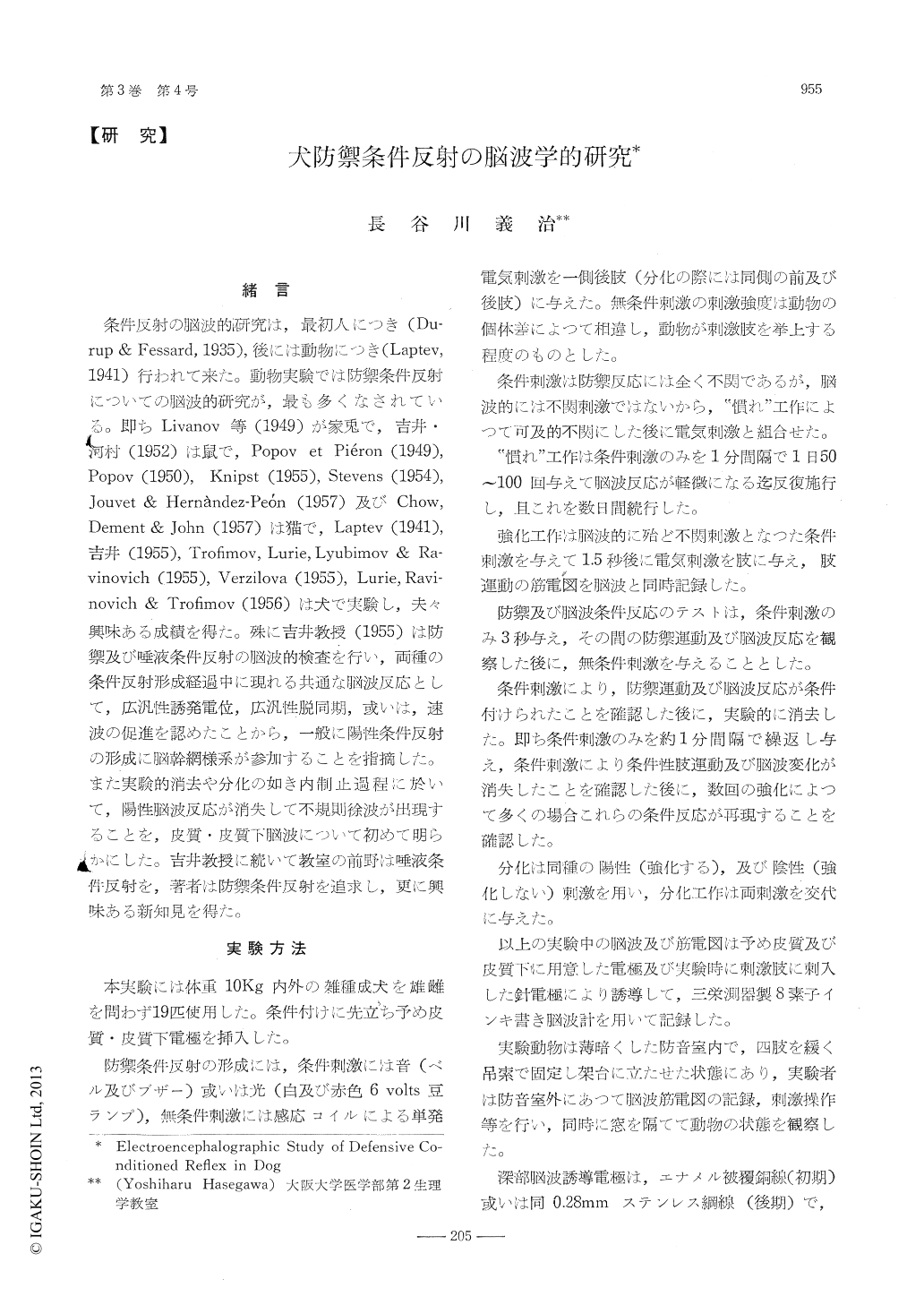Japanese
English
- 有料閲覧
- Abstract 文献概要
- 1ページ目 Look Inside
緒言
条件反射の脳波的研究は,最初人につき(Durup & Fessard,1935),後には動物につき(Laptev,1941)行われて来た。動物実験では防禦条件反射についての脳波的研究が,最も多くなされている。即ちLivanov等(1949)が家兎で,吉井・河村(1952)は鼠で,Popov,Piéon(194),Popov(1950),Knipst(1955),Stevens(1954),Jouvet & Hernàndez-Peón(1957)及びChow,Dement & John(1957)は猫で,Laptev(1941),吉井(1955),Trofimov,Lurie,Lyubimov & Ravinovich(1955),Verzilova(1955),Lurie,Ravinovich & Trofimov(1956)は犬で実験し,夫々興味ある成績を得た。殊に吉井教授(1955)は防禦及び唾液条件反射の脳波的検査を行い,両種の条件反射形成経過中に現れる共通な脳波反応として,広汎性誘発電位,広汎性脱同期,或いは,速波の促進を認めたことから,一般に陽性条件反射の形成に脳幹網様系が参加することを指摘した。
Defensive conditioned reflex was establishedin the dog from which cortical and subcorticalactivities were recorded. The results are summarized in the following.
(1) By the conditioned stimulus (sound orlight) were elicited at first generalized evokedpotentials (on-effect) followed by generalizeddesynchronization or augmented fast waves inthe cortical and subcortical electrograms. About5c/s waves simultaneously induced occasionallyfrom the amygdaloid, fimbria fornicis, zona incerta, n. lateralis posterior, tractus habenulopeduncularis, putamen, n. medialis dorsalis and n. caudatus. These responses were almost completelyabolished by process of habituation.
(2) After the animal was habituated to theconditioned stimulus so that the conditionedstimulus became electroencephalographicallynearly indifferent, the conditioned stimulus waspaired with an electrical shock stimulus to onelimb to form the defensive reflex. There appeared in the EEG in the early stage of conditioning generalized evoked potentials (on-effect)and generalized desynchronization or augmentedfast waves and, on continued reinforcement, 5c/swaves from the hippocampus, amygdaloid, tractus habenulopeduncularis, reticular formation, n. lateralis, hypothalamus lateralis, commissuraposterior, n. commissurae posterioris, zona incerta, stria medullaris, n. medians dorsalis, n. lateralis posterior, n. ventralis anterior, n. ventralis lateralis, n. ventralis posteromedialis andn. caudatus. The occurrence of the 5c/s wavesin this instance was more widespread than inthe early stage of conditioning when they wereelicited by the unconditioned stimulus alone. Itwas notable that the 5c/s waves spread over thethalamic reticular system and allied nuclei.
(3) On experimental extinction, these EEGresponses to the positive conditioned stimulusdisappeared later than the peripheral responsedid, and alterations in the EEG occurred in thereverse sequence to that in the course of conditioning the positive reponse. Further unpairedtrials resulted in augmentation of fundamentalwaves and irregular slow waves.
(4) A negative stimulus (differentiation) elicited at first the positive effects electroencephalographically as well as peripherally but theeffects became inconspicuous in the stage ofdifferentiation, that is, the negative stimulusbecame to elicit augmented fundamental wavesor irregular slow waves.
(5) It is suggested from these results thatparticipation of the activities of brain stem reticular system and amygdaloid-hippocampal systemis essential for a conditioned reflex to be formed, and that excitation in the amygdaloid-hippocampal system spreads to the mesencephalic anddiencephalic, especially the thalamic reticularsystem.

Copyright © 1959, Igaku-Shoin Ltd. All rights reserved.


